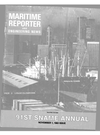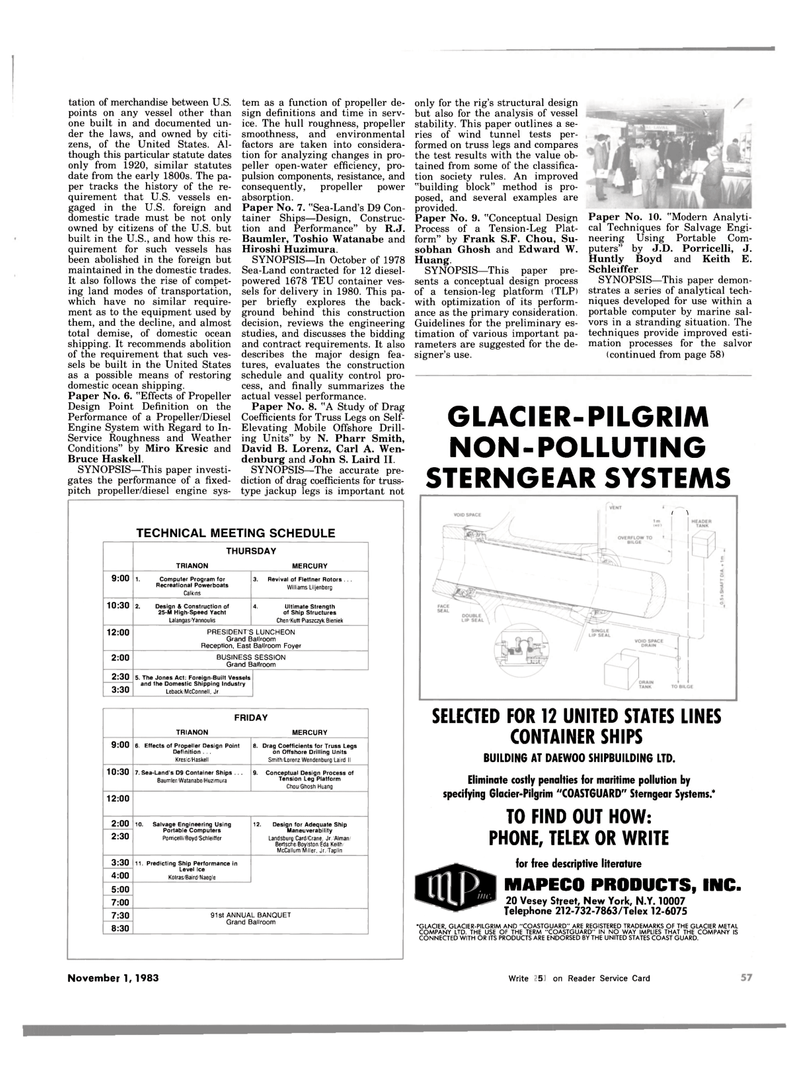
Page 51: of Maritime Reporter Magazine (November 1983)
Read this page in Pdf, Flash or Html5 edition of November 1983 Maritime Reporter Magazine
tation of merchandise between U.S. points on any vessel other than one built in and documented un- der the laws, and owned by citi- zens, of the United States. Al- though this particular statute dates only from 1920, similar statutes date from the early 1800s. The pa- per tracks the history of the re- quirement that U.S. vessels en- gaged in the U.S. foreign and domestic trade must be not only owned by citizens of the U.S. but built in the U.S., and how this re- quirement for such vessels has been abolished in the foreign but maintained in the domestic trades.
It also follows the rise of compet- ing land modes of transportation, which have no similar require- ment as to the equipment used by them, and the decline, and almost total demise, of domestic ocean shipping. It recommends abolition of the requirement that such ves- sels be built in the United States as a possible means of restoring domestic ocean shipping.
Paper No. 6. "Effects of Propeller
Design Point Definition on the
Performance of a Propeller/Diesel
Engine System with Regard to In-
Service Roughness and Weather
Conditions" by Miro Kresic and
Bruce Haskell.
SYNOPSIS—This paper investi- gates the performance of a fixed- pitch propeller/diesel engine sys- tem as a function of propeller de- sign definitions and time in serv- ice. The hull roughness, propeller smoothness, and environmental factors are taken into considera- tion for analyzing changes in pro- peller open-water efficiency, pro- pulsion components, resistance, and consequently, propeller power absorption.
Paper No. 7. "Sea-Land's D9 Con- tainer Ships—Design, Construc- tion and Performance" by R.J.
Baumler, Toshio Watanabe and
Hiroshi Huzimura.
SYNOPSIS—In October of 1978
Sea-Land contracted for 12 diesel- powered 1678 TEU container ves- sels for delivery in 1980. This pa- per briefly explores the back- ground behind this construction decision, reviews the engineering studies, and discusses the bidding and contract requirements. It also describes the major design fea- tures, evaluates the construction schedule and quality control pro- cess, and finally summarizes the actual vessel performance.
Paper No. 8. "A Study of Drag
Coefficients for Truss Legs on Self-
Elevating Mobile Offshore Drill- ing Units" by N. Pharr Smith,
David B. Lorenz, Carl A. Wen- denburg and John S. Laird II.
SYNOPSIS—The accurate pre- diction of drag coefficients for truss- type jackup legs is important not
TECHNICAL MEETING SCHEDULE
THURSDAY
TRIANON MERCURY 9:00 1. Computer Program for
Recreational Powerboats
Calkins 3. Revival of Flettner Rotors . . .
Williams/Liljenberg 10:30 2. Design & Construction of 25-M High-Speed Yacht
Lalangas/Yannoulis 4. Ultimate Strength of Ship Structures
Che n/Ku tt/Pi aszczy k/ B i en i e k 12:00 PRESIDENT'S LUNCHEON
Grand Ballroom
Reception, East Ballroom Foyer 2:00 BUSINESS SESSION
Grand Ballroom 2:30 3:30 5. The Jones Act: Foreign-Built Vessels and the Domestic Shipping Industry
Leback/McConnell, Jr
FRIDAY
TRIANON MERCURY 9:00 6. Effects of Propeller Design Point
Definition . . .
Kresic/Haskell 8. Drag Coefficients for Truss Legs on Offshore Drilling Units
Smith/Lorenz/Wendenburg/Laird II 10:30 7. Sea-Land's D9 Container Ships .. .
Baumler/Watanabe/Huzimura 9. Conceptual Design Process of
Tension Leg Platform
Chou/Ghosh/Huang 12:00 2:00 2:30 10. Salvage Engineering Using
Portable Computers
Porricelli/Boyd/Schleitfer 12. Design for Adequate Ship
Maneuverability
Landsburg/Card/Crane, Jr. Alman/
Bertsche/Boylston/Eda/Keith/
McCallum/Miller, Jr./Taplin 3:30 4:00 11. Predicting Ship Performance in
Level Ice
Kotras/Baird/Naegle 5:00 7:00 7:30 8:30 91st ANNUAL BANQUET
Grand Ballroom only for the rig's structural design but also for the analysis of vessel stability. This paper outlines a se- ries of wind tunnel tests per- formed on truss legs and compares the test results with the value ob- tained from some of the classifica- tion society rules. An improved "building block" method is pro- posed, and several examples are provided.
Paper No. 9. "Conceptual Design
Process of a Tension-Leg Plat- form" by Frank S.F. Chou, Su- sobhan Ghosh and Edward W.
Huang.
SYNOPSIS—This paper pre- sents a conceptual design process of a tension-leg platform (TLP) with optimization of its perform- ance as the primary consideration.
Guidelines for the preliminary es- timation of various important pa- rameters are suggested for the de- signer's use.
Paper No. 10. "Modern Analyti- cal Techniques for Salvage Engi- neering Using Portable Com- puters" by J.D. Porricelli, J.
Huntly Boyd and Keith E.
Schleiffer
SYNOPSIS—This paper demon- strates a series of analytical tech- niques developed for use within a portable computer by marine sal- vors in a stranding situation. The techniques provide improved esti- mation processes for the salvor (continued from page 58)
GLACIER-PILGRIM
NON-POLLUTING
STERNGEAR SYSTEMS i \
SELECTED FOR 12 UNITED STATES LINES
CONTAINER SHIPS
BUILDING AT DAEWOO SHIPBUILDING LTD.
Eliminate costly penalties for maritime pollution by specifying Glacier-Pilgrim "COASTGUARD" Sterngear Systems/
TO FIND OUT HOW:
PHONE, TELEX OR WRITE for free descriptive literature
MAPECO PRODUCTS, INC. Telephone 212-732-7863/Telex 12-6075
•GLACIER, GLACIER-PILGRIM AND "COASTGUARD" ARE REGISTERED TRADEMARKS OF THE GLACIER METAL
COMPANY LTD. THE USE OF THE TERM "COASTGUARD" IN NO WAY IMPLIES THAT THE COMPANY IS
CONNECTED WITH OR ITS PRODUCTS ARE ENDORSED BY THE UNITED STATES COAST GUARD.
November 1, 1983 Write 605 on Reader Service Card
13

 50
50

 52
52
